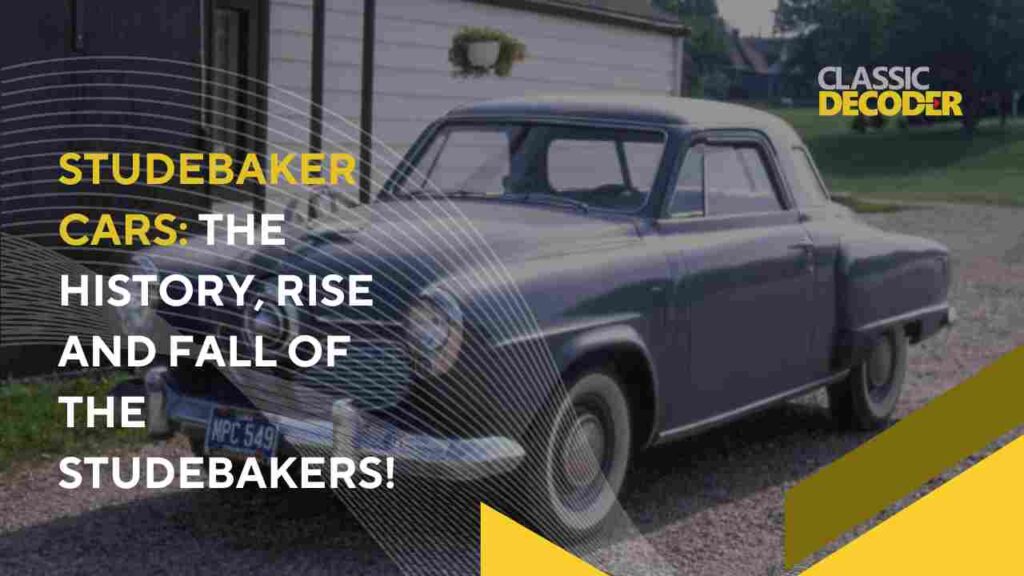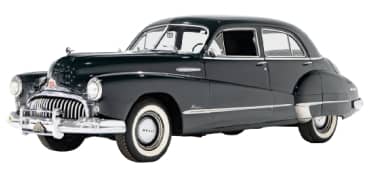Studebaker manufactured cars for over 100 years and used to be one of the biggest names in the automotive industry.
The Studebaker brand is a leading innovator in car design with a captivating story from its humble beginnings in the mid-1800s as a wagon manufacturer to its heyday in the 1950s and 60s.
Moreover, understanding the features of these classics for maintenance and appreciation will add value for both owners and enthusiasts.
This article discusses some of the defining features of the Studebaker cars, the reasons behind their business decline, and provides some helpful tips for keeping them in top condition.
READ ALSO: Top 11 Best Classic Muscle Cars Of All Time
What is So Special About Studebaker Automobiles?
Studebaker cars are admired because of their outstanding features, which combine visual look and engineering novelty. Since their very appearance in the car market, they turned out to be outstanding because of their stylish design and functionality.
First of all, it is their engineering that, for that time, was quite progressive; thus, the independent front suspension applied in the 1947 Commander provided better handling and comfort during driving.
Aesthetically, Studebaker cars often featured bold lines and unique body styles, especially in the post-war years, of which models such as the Avanti featured a sleek-even futuristic design that would, if anything, still turn heads today.
Their commitment to craftsmanship and quality set them apart from competitors and made the brand close to a preeminent symbol of American ingenuity in halcyon days. This combination of style and engineering made Studebaker cars the prize, not only in performance but also as collector’s items among classic car enthusiasts.
A Brief History of Studebaker
Studebaker’s journey began in 1852 when the Studebaker brothers founded it as a manufacturer of wagons in South Bend, Indiana. They built their first two wagons for business owners and for traveling throughout the country.
The maiden Studebakers were covered wagons that helped develop the American West. By 1860, Studebaker was already manufacturing thousands of covered wagons that most early settlers in America valued and enjoyed for traveling.
By the turn of the century, the car company tagged themselves “The World on Wheels” and transitioned to automobile production to make their first electric vehicle in 1902. This was followed by their first gas-powered model two years later. In the 1920s, Studebaker was already a top automotive brand. For instance, the popular 1920 Studebaker Big Six model was a great-looking, rugged automobile with a refined design.
In 1909, Studebaker sold $9.5 million worth of automobiles. However, the company stopped selling electric cars in 1911 and became the Studebaker Corporation.
The highlights in their automotive history include:
- 1914: The first Studebaker car powered by gasoline, the Studebaker 4, was introduced.
- 1939: The Studebaker Champion was introduced, easily recognizable by its fresh, innovative design and streamlined-weathered body.
- 1953: Avanti released a combination of performance with striking design; it stands out as one of the most iconic automobiles to bear the name.
After several successful decades, the company fell victim to changed market conditions in the 1960s and dwindled to reduced production until early in the decade.
Today, however, the legacy of Studebaker remains alive and very well in the car universe. Studebaker manufactured several different car models with which various collectors and enthusiasts alike have fallen in love.
Here is an exclusive list of some of the best:
- Studebaker Avanti (1962-1963): A car renowned for style and avant-garde features, Avanti was among those very few cars that pioneered advanced design coupled with luxury features in aerodynamics.
- The Studebaker Champion: 1939-1958. This is the classic that personified post-war American optimism, mainly because this car had been popularly recognized due to its affordability, reliability, and distinctive styling.
- Studebaker Commander: 1935-1964. This was a somewhat versatile model, which changed many faces throughout the years, offering different body styles and options to appeal to varied tastes and needs.
- Studebaker Golden Hawk: 1956-1958. The supercharged V8 engine and striking design make the Golden Hawk the epitome of Studebaker’s performance range.
- Studebaker Lark, 1959-1966: Being a compact car, Lark gained favor for being practical and economical, thus being a very good option for families during the years of its manufacture.
These models reflect not only engineering and design skills but also a great deal of historical significance, which makes them beloved collectibles today.
READ ALSO: Best Popular Cars of the 1960s: Greatest Car Makes and Models in the 60s
Why Did Studebaker Go Out of Business?
Several factors combined eventually brought Studebaker down in 1966. The 1950s and the 1960s were changing years for the automobile industry, with increasing pressure from larger companies such as General Motors and Ford. Studebaker fell farther and farther behind during this period, struggling against many problems, including:
- Market Conditions: The shift in consumer preference to larger cars and the growing foreign imports hurt sales.
- Internal Issues: Ineffective management decisions and financial mistakes took away from the potential for innovation and change within the organization.
- Production Constraints: There were limitations in production because Studebaker was one of the smaller producers compared to most of its competitors.
These factors led to a decline that finally resulted in the closedown of its South Bend plant in December 1963. The chronology of Studebaker’s decline can be traced by identifying some key dates, which are as follows:
- 1950s: Market share starts to shrink amidst emerging competition.
- 1963: The Company announces the shutdown of its South Bend facility, which equates to a significant cutback in production capacity.
- 1964: The last automobiles bearing the name Studebaker roll off assembly lines in Hamilton, Ontario.
- 1966: Studebaker officially stops the production of automobiles, thus ending the rich history in the automotive arena.
The brand witnessed a partial revival in the late 1960s with diversified partnerships to get back into the market. None of them really clicked.
Some Maintenance Tips for Your Studebaker Car
Due to the age of a Studebaker car, you should be intentional about its maintenance if you own one. Here are some useful tips to keep your classic Studebaker in good condition:
- Regular checks of important components such as brakes, tires, and fluid levels are highly recommended. The more the car ages, the more it wears out. So, the earlier the problem is spotted, the less costly the repair.
- Due to their rarity, finding original parts may not be that easy. Check special shops, online marketplaces, and Studebaker enthusiast groups for resources.
- Try as much as possible to retain originality in the car during the repair process. This includes using original colors and materials for paints, which no doubt add a lot of value to the car.
- Utilize the services of mechanics specializing in classic cars or even more precisely, Studebakers. Their expertise can be quite useful in preserving the integrity of the vehicle.
If you’re buying a Studebaker, you might consider getting a classic vehicle history report to track its maintenance history. This report shows previous repairs and identifies possible future needs, allowing you to keep it to factory specs.
READ ALSO: How To Perform An Old Car VIN Lookup? Explained
Preserving Studebaker Cars’ Automotive Legacy
It is up to current owners and enthusiasts, to a large extent, whether the heritage of Studebaker cars will be preserved.
Events like car shows, membership in Studebaker clubs, or joining online forums will be very helpful for appreciating them and keeping interest in the brand alive.
Furthermore, with the availability of repair shops and restoration services specializing in Studebakers, such vehicles can be renovated and kept with great love for future generations.
Conclusion
Each Studebaker car represents something special from another era, characterized by its distinctive features and innovative spirit. Knowledge of the characteristics of this car, along with proper maintenance, is critical not only to enthusiasts but also to owners. In that respect, participating in Studebaker communities and utilizing specialized tools and services like the classic VIN check and build sheet tools can help dig up the hidden history and verify car specs and features, respectively, ensuring these iconic vehicles are kept in good condition for many years.
Frequently Asked Questions
Why did Studebaker stop making cars?
Studebaker stopped manufacturing cars in 1966 due to increased competition, poor management decisions, and a failure to change with the market. They financially overextended themselves by buying Packard, and then the workers at their South Bend plant went on strike, which financially crippled the company. They just weren’t cost-competitive vs. Ford, GM, or Chrysler.
What is the most popular Studebaker?
The most popular of all is the Studebaker Champion, which was highly regarded for its inexpensiveness, reliability, and unique design; for this, it was a favorite of many people during its production year in 1939.
What was the last Studebaker that was built?
The last Studebaker car to come off the line was a 1942 President Skyway model. Before World War II, Studebaker produced the Champion, Commander and President models for the 1941 and 1942 model years.

